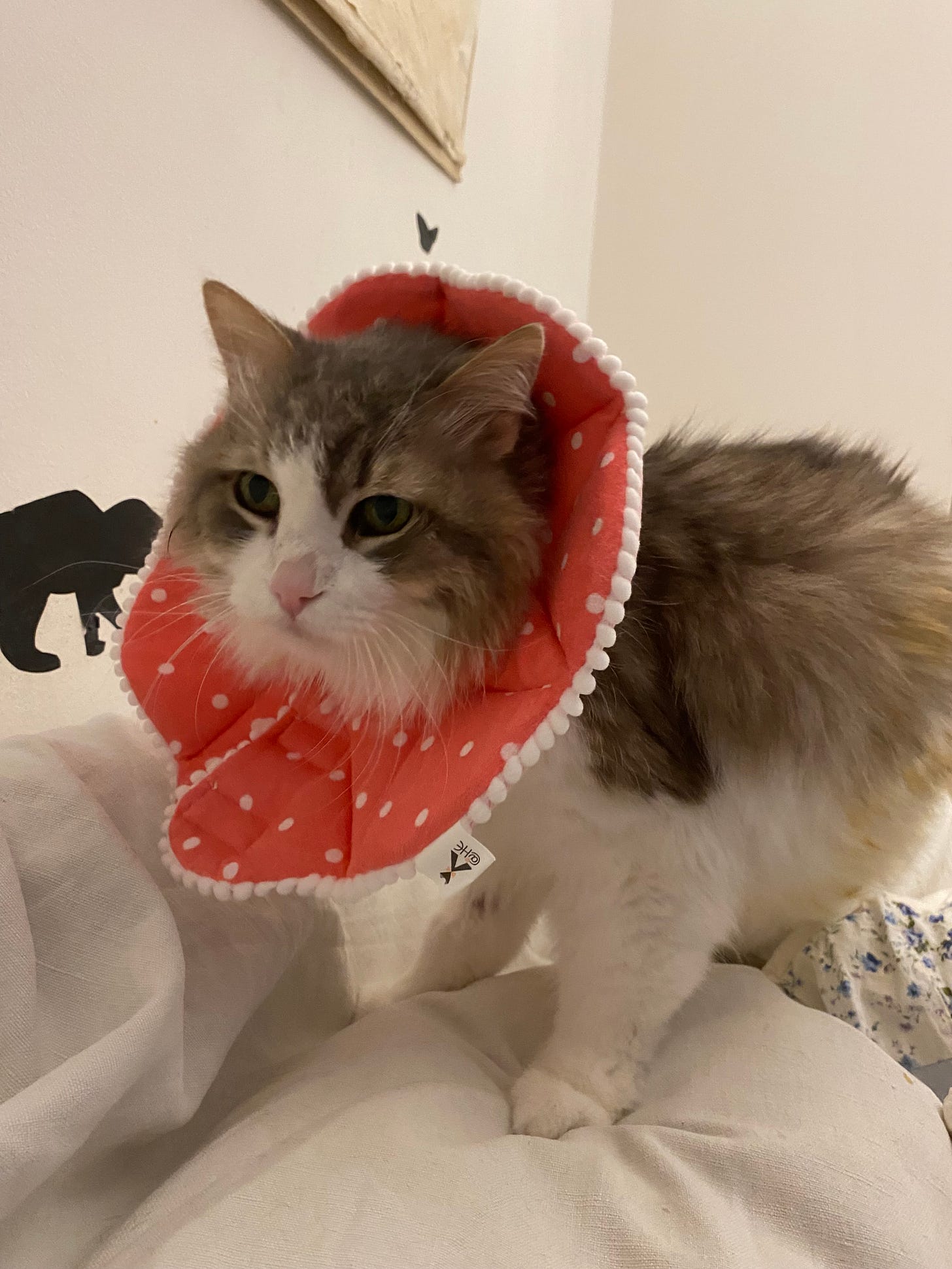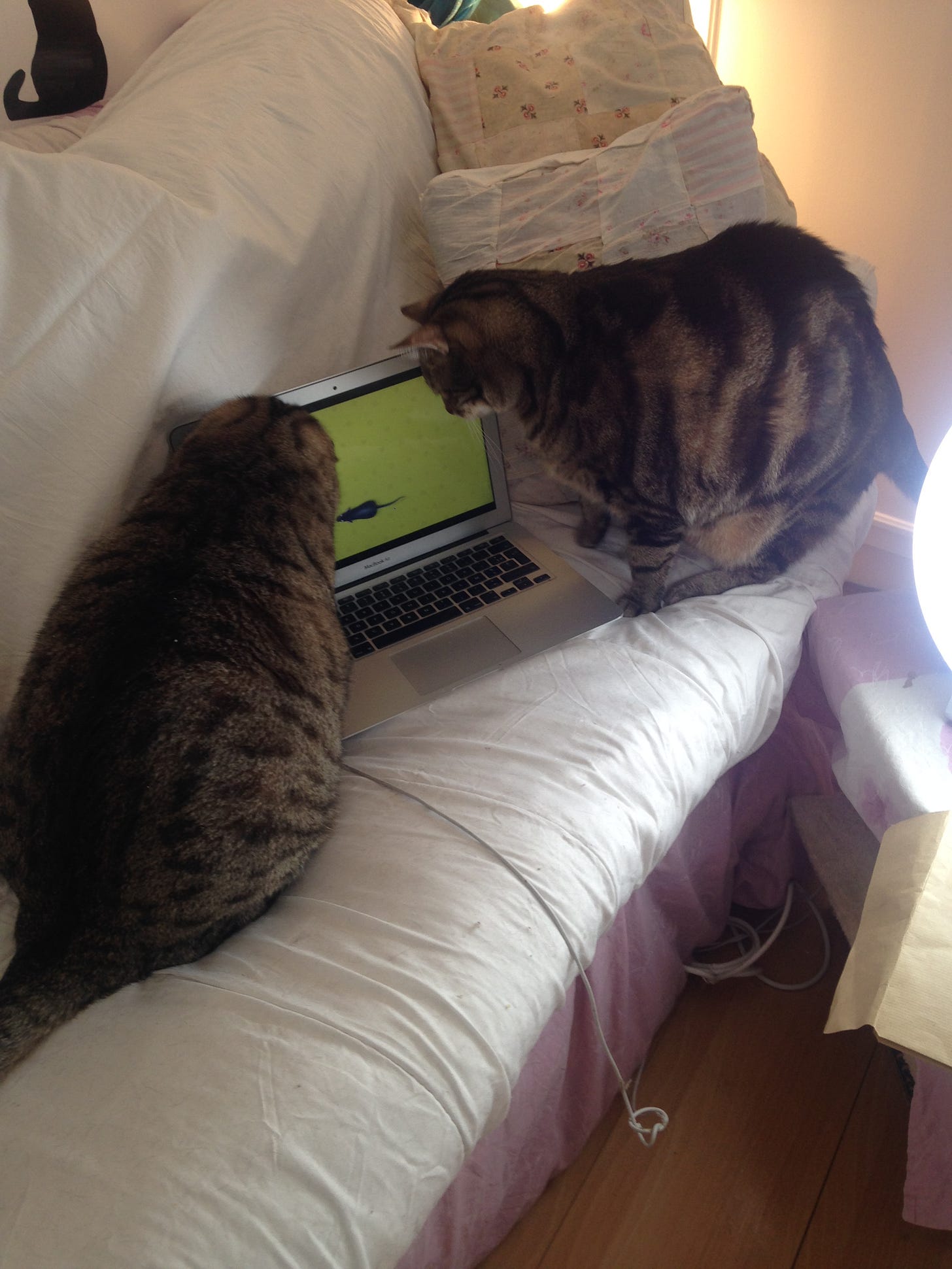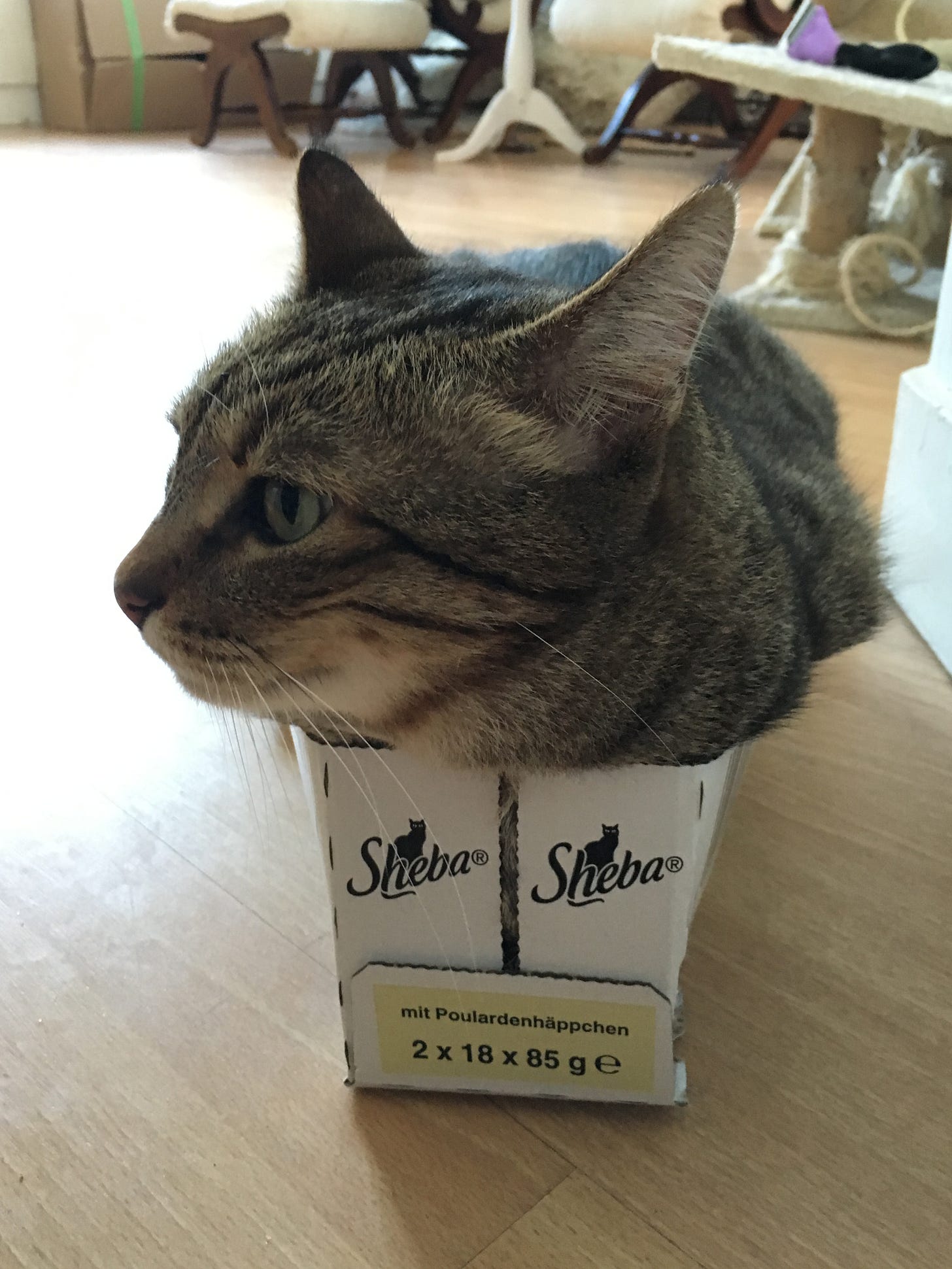Thank you again for all of your very sweet comments about Féline. Before we talk tanks—we’ll get there, Spin!—here’s the news. There’s good and bad.
All of the good news is about Féline. She’s home, and she’s doing better than I dared to hope.
I’d braced myself to be shocked on seeing her, and perhaps horrified, but I felt nothing of the sort. When the vet brought her out, wide-eyed and bewildered in her cone, my first reaction was astonishment: They were giving me back half as much cat as I’d brought them—how could she still be alive? The second was overwhelming, protective tenderness. I’d never seen something so fragile and helpless in my life.
They had to shave the right side of her body, and I just hadn’t realized that underneath all of that fur, there’s nothing to her. If I put my hands around the widest part of her torso, my thumb and first finger touch.
They didn’t just amputate her lower leg. They had to take off her whole haunch, so only her torso is left. Imagine pulling a drumstick off a tiny turkey and you’ll get the idea. Cats adapt better this way, they told me. I’m not sure why: Maybe it’s better for balance, or something to do with proprioception. And of course, they wanted to excise the tumor with the widest margins possible.
So she was furless, legless, and sewn up like a homemade rag doll. Without her fur, her anatomy was clearly visible—her ribs, her musculature, her breathing, her heartbeat. But amazingly, they cut open my cat, removed the lower half of her, stitched her back together, and she not only survived—she was just fine. There were no complications at all. She was alert, delighted to be alive, and very much still my Féline.
She was so happy when we got home. She hopped around the apartment with joy, sniffling every corner and litter box to reassure herself she was really back and nothing had changed, purring excitedly. Is she just high as a kite, I wondered? Or is she thanking God that I rescued her from those butchers before they ate another one of her legs? I have no idea how she understands what happened to her and what she’s thinking. But I do understand the main thing: She’s not suffering. She’s showing no sign of pain, shock, or depression. A bit of confusion, maybe, mostly because the collar gets in the way of her grooming herself. But she’s relaxed, purring, and eating like a wolf, even though the vet warned me that her appetite might take a few days to come back. She’s also very active—more active than she should be, in my judgement; I think she should be resting, and I’ve had to discourage her from hopping about too much. She seems to have no trouble hoppety-hopping in and out of the litter box. She’s even taken advantage of my sympathy to steal Suley’s favorite bed.
Poor Suley hasn’t taken this well. He’s easily three times her size, but he took one look at her when she wriggled out of her carrier and completely freaked out—Jesus, Mary and Joseph! It’s a ghastly hairless three-legged demon! He hightailed it under the bed and stayed there, hissing and trembling, until I distracted him from his sorrows with tuna.
The vets weren’t exaggerating when they assured me that cats take losing a leg much better than we do. Feline pain management is highly advanced. I find it extraordinary. A day after basically being cut in half, she was positively perky. She’s wearing a fentanyl patch, and I’m supposed to give her an anti-inflammatory called meloxidyl, which I mix with tuna juice and dribble into her mouth. (She likes it.)
I can clearly see why people take to fentanyl. What kind of black magic is that stuff? Capable of making an animal feel just great right after her leg’s been cut off?A week from now I’m to put on gloves, take off the patch, seal it tightly in a plastic bag, and return it to the clinic. “It’s forbidden to throw it in the garbage,” the vet told me gravely.
I was a bit offended: Did I look like the kind of woman who would Bogart my amputee cat’s painkillers? But apparently, it’s the law. France takes no chances when it comes to la toxicomanie. I guess they don’t want a bunch of jonesing three-legged housecats hopping out to Porte de la Chapelle and selling what remains of themselves for some skanky bag of skag.
Last night was the first I slept. On her first night home, even though she slept fine, I was so worried she’d break that I barely shut my eyes. Did she need anything? Would she like her ears scratched? Would she like me to warm up her hot water bottle? But she’s fine. The biopsy will suggest how much longer she’ll be fine, but for now, she’s happy to be home, she doesn’t miss her leg, and I love her more than I thought possible. She’s so plucky, and so sweet, and so vulnerable.
So that’s the good news.
The bad news is that Zeki isn’t doing well. I’d noticed over the past few weeks that he seemed lethargic and wasn’t as excited about his food as he usually is. I wondered if he might be stressed because Féline was occupying all my attention, or because he smelled the veterinarian on us. But then I noticed, too, that he seemed to have lost weight. I have enough experience of elderly cats to know that’s not a symptom you can ignore. As soon as I satisfied myself that it was safe to leave Féline alone for a few hours, I put Zeki in the carrier and carted him off to the vet. (Talk about a cat who didn’t want to get in that carrier: No, Claire! I’ll be good! Don’t eat my legs!)
Unfortunately, the news isn’t good. The bloodwork showed he has chronic kidney disease, which is what killed his brother Mo. I got him to the vet just in time. If I’d waited even a few more days, he would have crashed. His creatine levels were sky high. The other indicators are more optimistic: his blood pressure was only slightly elevated, his thyroid levels were normal, and so were his red and white blood cells. All of that is good and encouraging, but the high creatine levels are not.
The vet needs to keep him for four full days to flush him with water and stabilize his electrolytes. She can’t give me a prognosis until then, but even in the best of cases, CKD in cats is progressive, incurable, and fatal—although, in lucky cases, cats can live for several years with it in reasonable comfort.
He’s seventeen years old, which is much older than most cats live, so I’m telling myself that any time I have left with him is a bonus. All that matters is keeping him happy and free of pain and discomfort, for as best and as long as I can.
But the poor guy’s not happy right now. He’s exactly where he didn’t want to be: in a cage, with tubes in his veins and some strange-smelling ghoul pestering him, unaccountably determined to keep sticking a thermometer up his butt.
It’s too soon to say how bad this is, but it isn’t good.
Next week Suley goes to the vet, too. He has two brothers with CKD, so he’s almost certainly in the early stages of it. Most cats develop it if they live long enough. It’s a classic geriatric disease.
If Suley has it too, so be it. I’ll nurse all three of them. So long as I can keep them happy, I’d do it forever. But this is the sad part of loving an animal. Even in the best of circumstances, at this age they have, as they say in the hospice business, “a limited life expectancy.”
But then again, so do we all.








Awwww so cute. I have a cat too and she's awesome. Speedy recovery for your smols!
About those vet bills and making gift subscriptions...my one prospective recipient turned down the offer as he is already deluged with magazines and web-based material. I am, however, happy to extend my subscription for another year or two of CG, though, I'm not sure how your system works -- is it possible to sign up and pay now for an extra year? Maybe you could write a how-to piece for us clueless substack dummies..